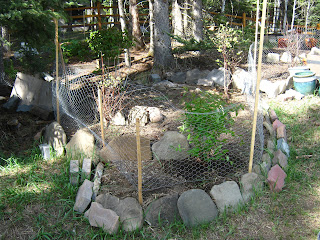As far as Day Jobs go, mine is pretty alright.
I work in a beautiful provincial park. I feel indebted to the foresight of environmentalists every time I drive to work here: as much as it can be while still being a tourist destination, this place is protected.
Unless there are weeds.
You see, the activities of us fun-loving humans have brought a few invasive species into this delicate mountain ecosystem. Some of them are classified as 'noxious weeds' throughout the province and are being aggressively sprayed with poisons recently shown in peer reviewed scientific literature to cause birth defects and cancers in mammals.
Like, you know, us humans.
Now, we thoughtful and good-looking humans who know a bit about ecosystems know that healthy ecosystems are far less susceptible to the advances of this invasive plants. Unfortunately, my particular place of work does not qualify as a healthy ecosystem. The accidental planting of weed-seed-contaminated, suited-to-warmer-climates grass as a landscape staple, and damage to the soil from ongoing construction have provided the perfect place for invasive dandelion and thistle.
So my boss has decided to spray herbicides. Here. In a supposedly protected provincial park.
The amount of thistle and dandelion is very minimal. It could be pulled by hand in a couple of days. Sure, it will likely come back. But guess what? It will come back if you spray it, too.
I've spoken with my boss about this twice now with no luck, and am waiting for a call back now that he has decided to go ahead in spite of my concerns... this Wednesday.
What are my concerns?
I'm glad you asked!
1. Herbicides hurt humans.
Most herbicides use glyphosate as their active ingredient. Glyphosate causes birth defects in humans. It is associated with long term health problems including cancer, especially cancer in children.
Herbicides are also known to cause respiratory distress. Many of the people who come to my place of work have respiratory problems to begin with. If we claim to be an accessible facility to people with special needs, we have to include respiratory needs in that claim.
2. Herbicides hurt the environment.
Glyphosate also “causes birth defects in the embryos of laboratory animals” according to Lucia Graves of the Huffington Post. Even low doses are shown to cause abnormalities in rabbits, including dilation of the heart.
It promotes soil pathogens and inhibits plants’ immune systems.
We are located in an extremely important watershed. Scientific American reports that glyphosate leeches into water.
Perhaps glyphosate is not the chemical that will be used here. Perhaps it is aminocyclopyrachlore, another common herbicide claimed to be more environmentally friendly, which causes mass tree deaths, especially in conifers.
Perhaps it’s the popular atrazine, which is still present in ground water 15 years after its use, causes breast and prostate cancer, and reproductive defects in birds, fish and frogs.
Either way, I cannot fathom how something so harmful to flora and fauna can legally be applied in a supposedly protected area.
On top of all of that, my partner and I are going to be starting a family soon. How could I conscionably expose myself to chemicals that could cause birth defects and / or cancers in my babies? My workplace will be sprayed on Wednesday. I'm supposed to work on Friday.
The mostly-wild places of Kananaskis Country are under enough pressure from tourists, logging and damns without having poisons sprayed on them.
Re-posted from
www.kathrynhogan.ca/writersblog where Sassy Advice is a fun and frequent feature.




